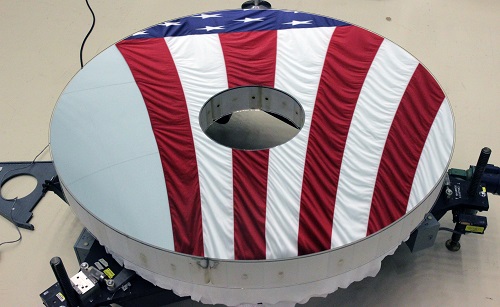
Primary Mirror Completed for NASA’s Roman Space Telescope
The Nancy Grace Roman Space Telescope’s primary mirror has been completed, NASA announced. The telescope will have a field of view 100× greater than the Hubble Space Telescope, and it will use infrared light to study hidden structures.
The mirror is 2.4 m across, the same size as the Hubble Space Telescope’s main mirror, though it is less than one-fourth of the weight. The mirror is 186 kg, owing that reduction to improved technology. In concert with other optics, the mirror will transmit light to Roman’s two scientific instruments, the Wide Field Instrument and the Coronagraph Instrument.

The Roman Space Telescope’s primary mirror reflects an American flag. Its surface is figured to a level hundreds of times finer than a typical household mirror. Courtesy of L3Harris Technologies.
The Wide Field Instrument is an enormous 300-megapixel infrared camera that provides the same sharp resolution as the Hubble across approximately 100× the field of view. Scientists aim to use the instrument to map the structure and distribution of invisible dark matter, study planetary systems around other stars, and explore how the universe evolved to its present state.
The coronagraph will be used to block out the glare of stars and will allow astronomers to directly image planets in orbit around them. If the technology performs as anticipated, it will see planets that are almost a billion times fainter than their host star and enable detailed study of giant planets around other stars.
The telescope will be positioned approximately 930,000 miles away from Earth in the direction opposite the sun. Its barrel-like structure is designed to help to block out unwanted light from the sun, the moon, and Earth, and the distance ensures that the instruments will stay cool so that it can detect faint infrared signals.
The mirror, NASA said in a press release, is much further along than it typically would be at this stage in the development process; the mirror came to NASA secondhand from the National Reconnaissance Office. NASA has modified its shape and surface to meet Roman’s scientific objectives.
“Achieving this milestone is very exciting,” said Scott Smith, Roman telescope manager at NASA’s Goddard Space Flight Center. “Success relies on a team with each person doing their part, and it’s especially true in our current challenging environment.”
The resurfaced mirror sports a layer of silver less than 400 nm thick, approximately 200× thinner than a human hair. The coating was specifically chosen due to how well silver can reflect near-infrared light. By contrast, Hubble’s mirror is coated with layers of aluminum and magnesium fluoride to optimize visible and ultraviolet light reflectivity. The James Webb Space Telescope’s mirrors contain a gold coating to suit longer wavelength infrared observation.
The mirror is so finely polished that the average bump on its surface is 1.2 nm tall — more than twice as smooth as the mission requires.
“The mirror was precisely finished to the Roman Space Telescope’s optical prescription,” said Bonnie Patterson, program manager at L3Harris Technologies in Rochester, N.Y. “Since it’s so much smoother than required, it will provide even greater scientific benefit than originally planned.”
The next step will involve mounting the mirror for additional testing at L3Harris. The mirror has been tested extensively at both cold and ambient temperatures, though the new tests will be done with the mirror attached to its support structure.
The Nancy Grace Roman Space Telescope is managed at Goddard, with participation by NASA's Jet Propulsion Laboratory and Caltech/IPAC in Pasadena, Calif., the Space Telescope Science Institute in Baltimore, and a team of scientists from research institutions across the country.
Published: September 2020